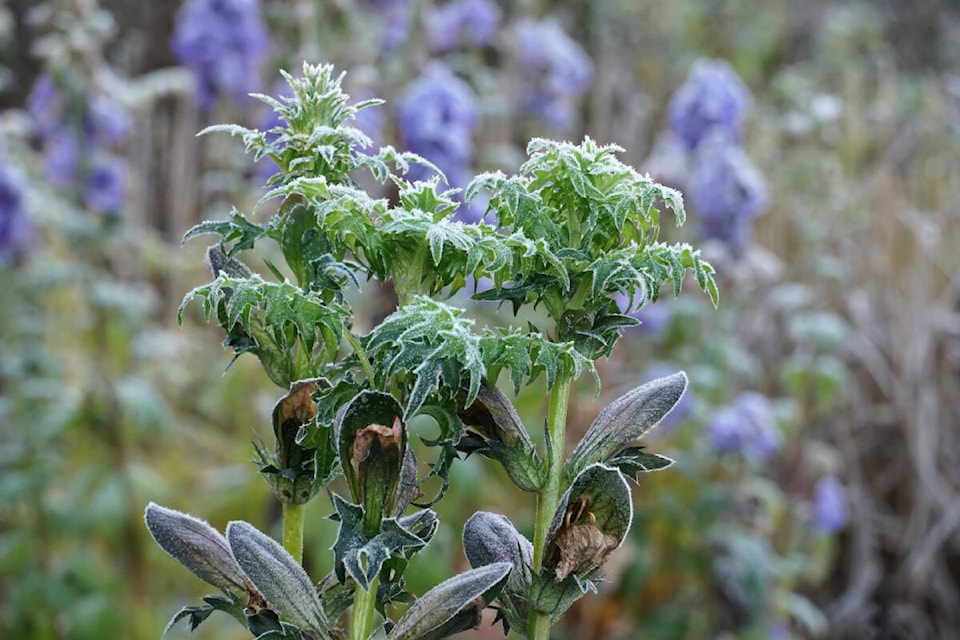By Leslie Cox
Special to the Record
There is new green growth on some of the Acanthus spinosus flower stalks, (spiny bear’s breeches). Couldn’t possibly be new floral growth in October, could it?
Very strange. I cannot remember seeing new growth on the acanthus in past years but that could have fallen to my lack of attention to weird details. Not likely, though, given my penchant for finding insects amongst the proliferation of foliage through spring and summer.
Thankfully, my memory recall is secure because John has assured me that he has never seen these growths, either. And he would know. The acanthus is in his garden.
Thinking about this phenomenon triggered a vague memory and after tickling it for a while I remembered “fasciation.” This is a word used in botany to reference abnormal growth in vascular plants.
It is a relatively rare occurrence which typically, but not always, occurs in the growing tip, causing the stem to become flattened like a corrugated ribbon, or crested, or contorts the tissue into elaborate shapes. I have seen a photo example of the last one showing a saguaro with large contorted knobs where its long, upright arms should have been. Quite the sight.
What causes fasciation? Well, it seems plants are quite capable of experiencing hormonal imbalances just as humans do. Poor things. And, because they can’t voice their hormonal angst, they quietly put it on full display to catch our attention.
But it may not be hormones that are causing the fasciation oddity. Could be from a bacterial, viral, or fungal infection of some sort. Plants get sick too.
In particular, botanists have identified the bacterial phytopathogen, Rhodococcus fascians as one that causes fasciation in sweet pea plants. But there are many other bacterial phytopathogens that could also cause fasciation.
Mite and insect attacks can cause viral infections that may trigger fasciation in the growing tip of a plant. Or it could be hidden in the genes of some plant species such as peas and Celosia. Commonly called “cockscomb”, the unique flower traits on some Celosia varieties are actually due to fasciation.
While genetic fasciation is not contagious, the other causes. Bacterial and viral fascination can spread from plant to plant through contact with wounds. Contaminated gardening implements are typical culprits but a brisk wind can also push an infected plant up against other plants nearby.
As for the mystery of whether John’s acanthus has developed fasciated growth tips… it appears that exposing the growth tip to cold and frost can also cause fasciation.
So, I wonder if 1C to 2C temperatures through the early days of October constitute enough of a cold snap to produce these growth tips. Still, it would be strange for the acanthus to be pushing out new growth in the fall in my viewpoint. But what do I really know?
I have learned, however, that even though fasciation is relatively rare, it has been observed in more than 100 vascular plant families. To name a few genera: Prunus, Acer, Salix, Digitalis, Euphorbia, Primula, Delphinium, Forsythia and Echinacea. So, if you grow any of these in your garden, keep a close watch. You may just witness a unique plant oddity of your very own.
Speaking of oddities… we had a unique visitor to our garden recently. Our very first ruffed grouse. Scared the pants off me as it bolted out of the rhodo and up into my silver-leaf maple. But I recovered quickly and the bird obliged by sticking around for a photo shoot. Another unique visitor to go with our peacock and flock of chukars. Too bad I missed getting a photo of the snowy owl.
Leslie Cox co-owns Growing Concern Cottage Garden in Black Creek. Her website is duchessofdirt.ca



